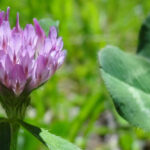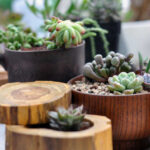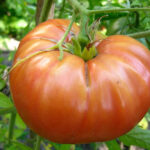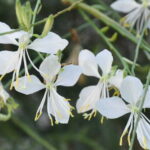Do you love tropical, humidity-loving plants with vibrant and stunning flowers? Perhaps you’re into odd spiky “air-plants” that seem to grow with no care at all? Do you enjoy the island flavor of roasted pineapple? Or do you prefer your trees all draped in thick, swaying coats of moss? How about drought-tolerant, heat-loving plants that act a bit like succulents?
If you answered “yes” to any of these, then you like some form of bromeliad. This incredibly diverse family of monopods includes all of the above and a whole lot more. While today we’re going to focus primarily on the bromeliaceae that are grown as flowering houseplants, we’ll also go over a bit of information about one of my favorite bromeliad fruits (the pineapple), as well as the carefree and easy-maintenance clinging-root varieties like Spanish moss or air plant, and even some of the drought-tolerant, succulent-like spiky varieties such as Puya.
Subscribe to the Epic Gardening Podcast on iTunes
There’s a lot of ground to cover, so let’s get started!
Bromeliad Overview
| Common Name(s) | Extremely varied, but popular varieties include Guzmania, Tillandsia, Aechmea, and Ananas species of plants among many others. |
| Scientific Name | Varied (see common name above) |
| Family | Bromeliaceae |
| Origin | Tropical & subtropical Americas, Africa |
| Height | Varies |
| Light | Bright indirect light |
| Water | Water into leaf well, from above, or mist depending on variety |
| Temperature | Tropical, 60-80 degrees preferred for most species |
| Humidity | Medium to high humidity |
| Soil | Depends on species, may not always require soil |
| Fertilizer | Bromeliad, ephiphyte, or air plant fertilizers preferred as needed |
| Propagation | Pups/offshoots |
| Pests | Mealybugs, Mexican Bromeliad Weevils, breeds mosquitos |
Types of Bromeliads
While I can’t list all the species of bromeliads in one singular article just because there’s so very many of them, I will list some of the subfamilies, and then go into a little more detail about a few select genera from each sub-family.
Tillandsioideae Sub-Family
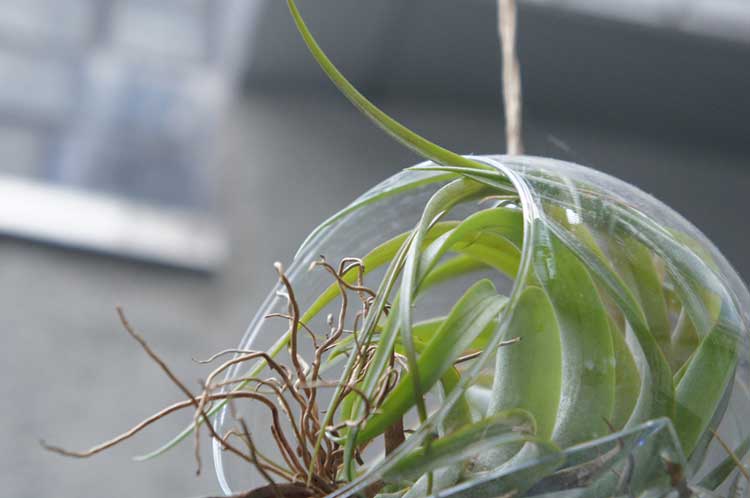 Air Plant in Hanging Container. source
Air Plant in Hanging Container. sourceThis sub-family contains only 9 genera, but has nearly 1300 species! Most of these plants absorb water and nutrients directly from the air or from their leaf-wells, but they often live in trees or on rocks. Popular genera include Guzmania, Vriesea, and Tillandsia. Most are epiphytic or lithophytic.
Guzmania
These are some of the most popular bromeliad houseplants out there! As of 2014, there were 214 species of Guzmania recognized by the World Checklist of Selected Plant Families, including hybrids. They are named after Anastasio Guzman, a noted Spanish pharmacist and naturalist who died in 1807. These evergreen perennials are common throughout South and Central America, southern Mexico, the West Indies and Florida. They have a weak root system that’s adapted to loose or rocky soil, and a large well or tank that holds the plant’s water supply. Check out Nell’s article about Guzmania for additional care information.
Guzmania lingulata ‘Scarlet Star’, ‘Droophead Tufted Airplant’
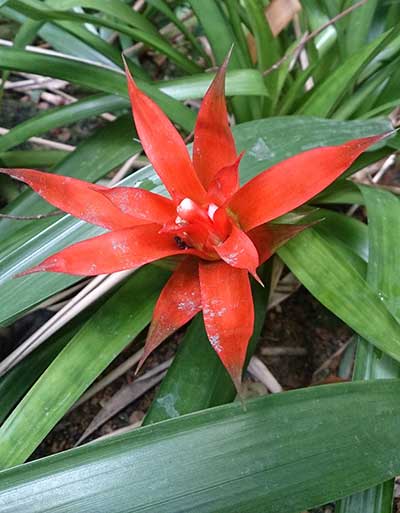 Guzmania lingulata Scarlet Star. source
Guzmania lingulata Scarlet Star. sourceThe word ‘lingulata’ means ‘tongue-shaped’ in Latin, and that well describes the flower petal shape for this vibrant plant. Long, slender evergreen leaves are topped by a single brilliant inflorescence of tongue-like petals. Depending on the varietal, the bloom will be deep red, maroon, orange, pink, or yellow – or even some combination of the above. It has been granted the Award of Garden Merit by the Royal Horticultural Society, and is easily the most popular Guzmania available today. Selected varietals of Guzmania lingulata include ’cardinalis’, ‘concolor’, ‘flammea’, and ‘lingulata’.
Vriesea
While the Vriesea are related to Guzmania, they have one dramatic difference. Vriesea are almost all epiphytes – they tend to grow soilless on tree branches, and their roots are meant purely to hold them in place rather than to absorb any nutrients. Their leaves create an indentation or well which holds a small amount of water for the plant, and they produce a single flower per plant. Vriesea also tend to reds, yellows, and pinks in hue.
Vriesea splendens ‘Flaming Sword’, ‘Painted Feather’
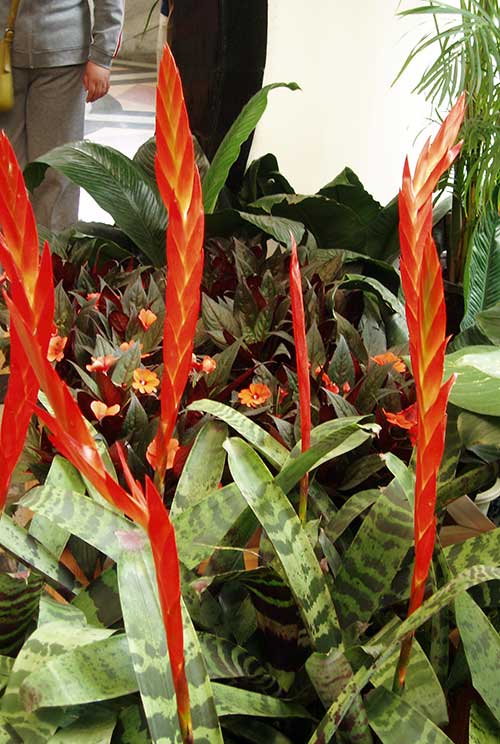 Vriesea splendens. source
Vriesea splendens. sourceBroad, flat leaves in green shades with brown horizontal banding reach 8-24” in length. Atop this is the flower spike, which is bright red and extends well above the foliage. Other Vriesea splendens cultivars have different shades, but this one truly resembles a flaming sword. It is also occasionally referred to as ‘Tillandsia splendens’, although it isn’t a Tillandsia.
Tillandsia
Another epiphyte species of bromeliad, the Tillandsia are sometimes aerophytes as well – plants which lack roots entirely, and which live on sandy soil. This category is incredibly wide-ranging with about 730 species, and it contains the vast majority of plants considered “air plants”.
Tillandsia aeranthos ‘Aeranthos air plant’
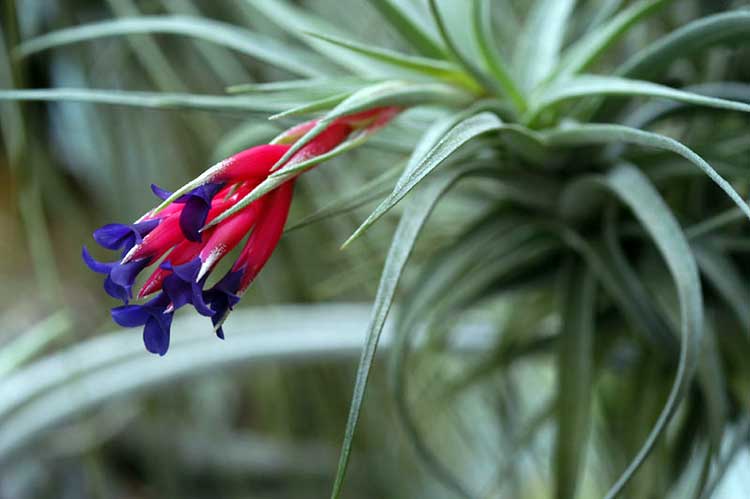 Tillandsia aeranthos. source<‘a>
Tillandsia aeranthos. source<‘a>With stiff, sharp-pointed leaves that create almost a conelike structure, the Tillandsia aeranthos is a clean green hue. It rarely grows much larger than 10” in diameter, and sends up a central shoot from which springs a pink flower base with a purple top that’s much-admired. Super-easy to care for, it’s a popular choice for both indoors and outdoors.
Tillandsia usneoides ‘Spanish Moss’
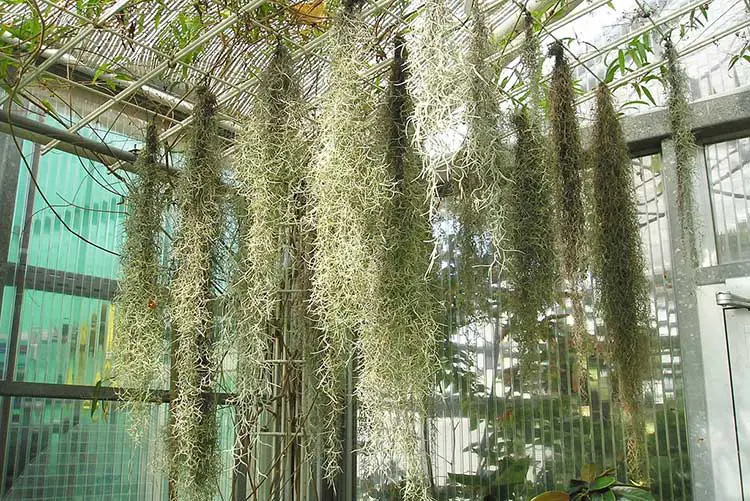 Tillandsia usneoides or Spanish Moss. Source: blumenbiene
Tillandsia usneoides or Spanish Moss. Source: blumenbieneThis is a bonus example for the Tillandsia species. It’s so common that I can’t help but to mention it! That long, tendril-like mossy stuff that drapes nearly every oak or cypress tree throughout swamplands in the southeast US is, in fact, another bromeliad. It’s an aerophyte as well, surviving mostly on whatever moisture it absorbs during rainfall or from the air itself. It has no roots, and holds on to trees by draping over branches.
Pitcairnioideae Sub-Family
This sub-family of bromeliads developed over time in arid and high-altitude regions, which explains why it also has most of the succulent-like bromeliads. Unlike most of the bromeliads which we’ve discussed up until now, this group has normal roots like most other plants do, rather than vestigial grasping roots or no roots at all. Popular species include Pitcairnia and Puya, among others.
Pitcairnia
Pitcairnia is the second most prolific species of bromeliad, only trailing after Tillandsia by cultivar number. They tend to be very commonly grown as houseplants or as a tropical in planters, and are very popular. Most varieties of pitcairnia tend to have rounder leaves than their other bromeliad cousins.
Pitcairnia maidifolia ‘Stardust’, ‘Jim Scrivner’, ‘Verdia Lowe’
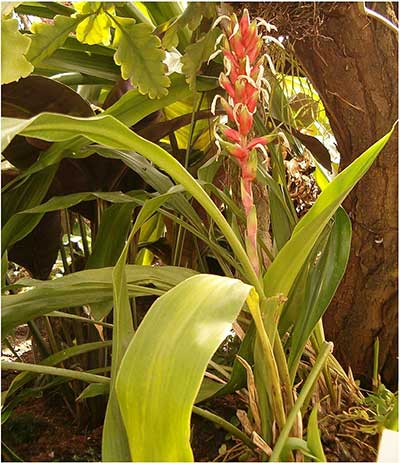 Pitcairnia maidifolia. source
Pitcairnia maidifolia. sourceBroad, round-tipped leaves spill out to form the foliage from which springs a brightly-colored stalk. Cylindrical flowers jut out from that central stalk to create a rather unusual display of color. The ‘Stardust’ variety is a dark-colored evergreen with a reddish stalk and white or off-white flower blossoms, and is popular amongst those who grow exotics.
Puya
This incredibly drought-tolerant, heat-tolerant species has about 100 cultivars. While it is most often grown in botanical gardens as many varieties have very sharp barbs on the stiff leaves, there are some varieties which make for beautiful centerpiece plants in a low-water landscape.
Puya alpestris ‘Sapphire Tower’
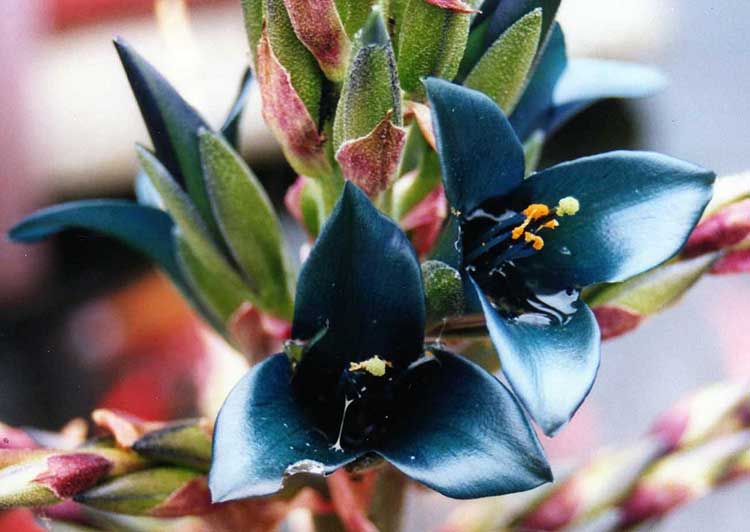 Puya alpestris. source: wallgrom
Puya alpestris. source: wallgromProbably the most likely puya for growing in a private garden, this species is variable. Some varieties have almost white leaves, others pale green, and the leaves tend to be curled, barbed, and flexible rather than rigid. These do not need to grow very large before flowering, and when they do, the flower stalk can get to 4’ tall. They are unusual flowers, with such unique and brilliant colors of blue-green to bluish-black that they are often mistaken for being fake!
Bromelioideae Sub-Family
This subfamily is the most diverse in terms of species, as there’s 32 different species in the bromelioideae. But for all that, they have the least diversity in terms of individual cultivars. These are also the most commonly cultivated, but that may in large part have to do with the ananas species, as you’ll see below. Popular species are Aechmea, Neoregelia, and Ananas.
Aechmea
Most aechmea are epiphytes. Their name, ‘Aechmea’, comes from the Greek word “aichme”, which means “a spear”. Their distinctly spearlike foliage is a beautiful landscape choice, and smaller cultivars make great houseplants.
Aechmea distichantha ‘Brazilian vaseplant’, ‘Vase plant’
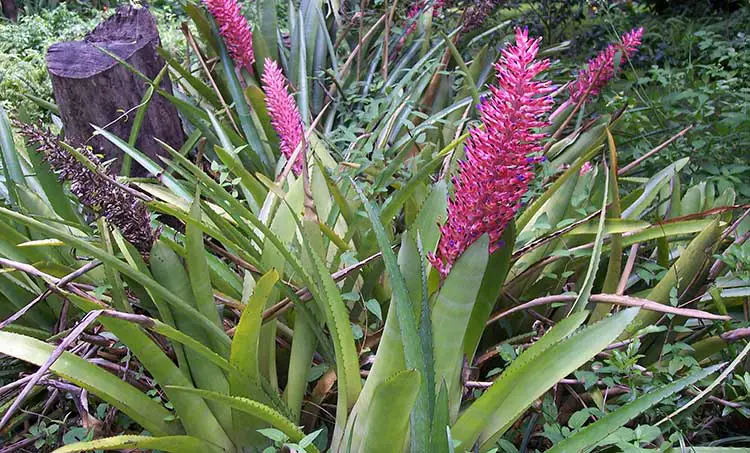 Aechmea distichantha. Source: Mmcknight24
Aechmea distichantha. Source: Mmcknight24This is the largest-growing bromeliad that is cold-hardy in the southern regions of the United States. The Brazilian vaseplant can reach about four feet across and has sharp spined leaves, but puts up a brilliantly pink inflorescence when it flowers. It’s drought-tolerant and semi-succulent in how it grows, and while it’s slow-growing, it does tend to spread over time. It handles shade very well, and is best grown under trees where it can benefit from their shelter.
Neoregelia
Neoregelias tend to have broad, mostly-flat leaves and are grown primarily for their multicolored foliage. The foliage tends to be banded or striped, and around the inflorescence is often quite brightly-colored in shades of red, yellow, pink or orange.
Neoregelia carolinae ‘Blushing Bromeliad’
 Neoregelia carolinae. source: Starr Environmental
Neoregelia carolinae. source: Starr EnvironmentalThe center of the blushing bromeliad begins to turn red or pink shortly before it is going to flower, which gives this unique plant its name. The remainder of its leaves remain a deep, dark green, and the flower plume itself can be many different colors although it’s often red, orange, pink or yellow. There’s about 220 different cultivars of the carolinae currently, including one named ’Dr. Who’ after the TV series, and they’re stunning houseplants.
Ananas
One can’t discuss the bromeliad family without including this species somewhere, because this is probably the most prolifically-grown bromeliad species. It’s not grown as a houseplant, although it can certainly be used as an outdoor ornamental. No, this particular species is grown primarily for the pineapple fruit, and is extensively farmed in tropical regions.
Ananas bracteatus ‘Red Pineapple’
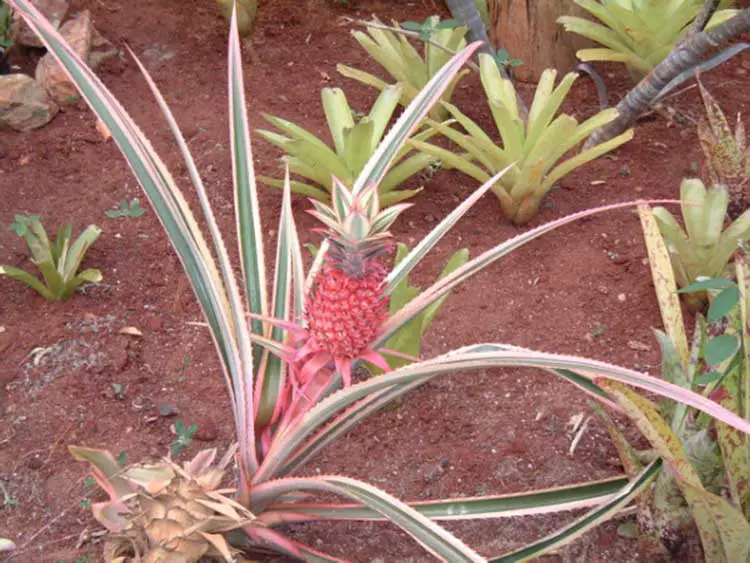 Ananas Ornamental. source
Ananas Ornamental. sourceWhile it’s not the pineapple most commonly farmed for the food industry, this particular species is far more likely to be raised as an ornamental. Growing to about 40” wide, the plant has long spined leaves that start as a dark green but turn red or pink when exposed to enough sunlight. The fruit that develops from its flower stalk also appears reddish on the exterior, making it a much prettier version to look at. It’s edible as normal pineapples are, but tends to be much smaller, and thus unsuitable for the food industry. The spiky leaves can be hazardous, so be careful not to grow this where small children or pets might go.
Other Sub-Families
While we’ve barely scratched the surface on the three sub-families we’ve listed so far, there’s so many more sub-families from here. We aren’t even going to discuss the Brocchinioideae, Lindmanioideae, Hechtioideae, Navioideae, and Puyoideae sub-families right now, mostly because the vast majority of the ornamentals fall into one of the groups I’ve already mentioned.
But there are some fantastic resources online to learn more about bromeliads. The BSI Bromeliad Cultivar Registry contains over 10,000 registered cultivars in its informational file. And there’s always the bromeliad encyclopedia produced by the Florida Council of Bromeliad Societies for a lot more information on different species, and they an extensive photo library of different bromeliads.
Bromeliad Care
Since there’s so many varieties of bromeliad, there’s different techniques required for their care. Let’s go over some of the basics for the most popular species.
Light
Most of the tillandsioideae family tends to prefer bright indirect lighting, which makes them fantastic houseplants. Aechmeas and neoregelias from the bromelioideae family also do well in shaded environments, although they do need indirect light as well.
Pitcairnioideaes like the puya and pitcairnia do well in full light, but the pitcairnia also does well if it’s shaded for part of the day. The ananas from the tillandsioideae family also do well in full light.
Water
The majority of bromeliads grown indoors are types which have a central “well” or cup of leaves. The well normally collects rainwater in the wild, and between the water in the plant’s well plus the ambient moisture in the air, they supply themselves quite efficiently.
Indoors, it’s a bit trickier. You need to maintain some water in the leaf well, but it needs to be drained out and emptied at least once a week so it does not go stagnant and cause rot. When the well is empty, use distilled water or rainwater to refill the leaf well, allowing the excess water to drain. If the weather is warm or humidity is low, you may need to water more than once a week, but allow the leaf well to dry out on its own before you water it again, and be sure to clean the well regularly.
Types which are typically soilless like tillandsia air plants do not have a well to hold water. Every 2 weeks, and always in the morning, place your air plant into a small dish of water for 20-30 minutes. After soaking, remove it from the bowl and shake off any excess moisture. Allow it to dry fully (1-3 hours) before placing it back in its normal container. Mist it with water occasionally between soaks (at least once a week and more in hotter, drier weather) so that the entire plant is moistened, but not dripping. Too much water will cause the plant to rot. If the tips of the leaves begin to turn brown and get dry, you are under-watering your plant.
Terrestrial varieties like the neoregelias and aechmeas need some moisture around their roots, but not much. If the soil is lightly moist but not wet, they should be fine. Do not water terrestrial varieties until the soil is dry, and water them from above so that they can also store their own water.
Over watering bromeliads is the most common cause of plant death, so it’s important to pay close attention to your variety and exercise caution.
Soil
Drainage is key for all bromeliads. There are specialty soils designed for terrestrial bromeliads, but if you don’t have access to a bromeliad mix, an orchid mix can work equally well. Remember, these plants tend to either hold their own water supply or draw it from the air around them — they aren’t accustomed to soils that hold lots of water!
For varieties that have grasping roots, you can grow them in a soilless medium like perlite. While you can still use bromeliad mixes for these, they seem to prefer the drier, more rock-like feeling of perlite. Wood bark chips are also a good and visually-appealing option.
For aerophytes, a bed of dry sand is ideal.
Fertilizer
Typically, bromeliads like a very weak fertilizer. There are special mixes meant for bromeliads, epiphytes, or air plants on the market, and if you can find those, use those. If you don’t have access to those, you can mix an all-purpose liquid houseplant fertilizer at half of its normal strength and use some of that on a monthly or bimonthly basis. Seaweed solutions and compost teas are also popular, although heavily diluted with water.
Air plants generally require the least fertilizer, and often don’t need any fertilization at all.
Propagation
Most bromeliads reproduce by what is called “pups” or offshoots – the plant forms a secondary plant at the original plant’s base. Somewhat similar to spider plant babies, except those form at the end of stems! This usually happens just after it has finished flowering. When these pups are about ⅓ of the size of the mother plant, they can carefully be separated from the parent plant and placed in their own container, or they can be left in place if you desire a large grouping.
Once the pups have been formed, the parent plant gradually will begin to wane, as it has expended its energy on flowering and creating offspring, so eventually the parent will need to be removed. At that time, carefully remove all of the plants from their pot. Look closely at their bases, as you can easily identify the pups at that time. Separate any which are at least a third of the parent’s size, making sure to keep some stem on each new plant, and select which plants you wish to keep.
Repotting
Over time, the soil you’re using for potting will start to get compacted, or you’ll have too many pups for your pot. At that point, separate out any pups that you wish to keep. Use fresh bromeliad or orchid mix to repot them. You can plant multiple plants in a single container, but remember that as they form pups, the container will get more crowded. Try to leave space for new growth.
You can reuse older soil mixes by blending in extra bark mix or perlite to reduce compaction, but it’s often easier to just start with a fresh batch of potting mix and to blend the older compacted batch with other soils for other plant purposes. If you are opting for growing in perlite or wood bark chips, you can just reuse those.
If you are preparing an environment for an air plant, all you need is sand and a container. People often grow air plants in open glass containers such as empty fishbowls, special blown-glass air plant “airiums”, or open-topped fishtanks. This helps keep a little more humidity around the plant, although you do want good airflow too. But an air plant can grow on a flat sandy surface like a plate, too. Just set the plant’s base into the sand and you’re done.
Pruning
Each bromeliad only makes a single flower in its lifecycle. While that flower can last for months and months, it will eventually start to turn ugly, go brownish, or just look unpleasant in general. With a pair of pruning shears, cut off the flower stalk as close to the plant’s center as you can. You can trim back some of the leaves on the mother plant as well if you want to encourage the development of the pups, but be sure to leave the leaves on the pups themselves.
Air plants typically don’t require much pruning at all other than to separate the pups on occasion. You can pinch off leaves that are starting to brown at the base of the plant to provide room for new growth. Air plants grow new leaves and lose the older ones naturally, so you may not need to prune them at all other than to remove the flower stalk once it’s past its prime.
Larger outdoor species of bromeliad may be harder to prune due to the woody nature of their leaves and stalks.
Problems
Bromeliads, as a general rule, are pretty self-reliant and problem free plants. The few problems that exist are listed below.
Growing Issues
There are a few very common growing issues that happen with bromeliads.
The leaf tips are turning brown. There’s two potential issues here. With air plants, tip browning is an indication that the plant may not be getting enough water. With most other bromeliads, tip browning is an indication that the plant is getting too much direct sunlight, and that you should move it to a location with more indirect bright lighting.
The plant is drying out. Some species of bromeliad like a more humid environment than others – neoregelias are a good example of one of the humidity-loving plants. If this happens, take a bowl or tray with small rocks or pebbles in it and add some water, and place this near the plant. This should increase the humidity near the plant and improve it.
There’s a chalky, salt-like substance in my plant’s well. This is often an issue if you’re watering with tap water or high-mineral content waters, as when it dries out it leaves behind a residue. Carefully wipe out the plant’s well or tank with a dampened cloth. Overfertilizing can also cause a residue on the plant’s foliage.
My bromeliad is only dark green rather than variegated like it’s supposed to be. If this is happening, your plant is probably not getting enough bright, indirect light. Move it to a brighter location.
Pests
Pests aren’t common with bromeliads, but there are a few that appear from time to time.
Both indoors and outdoors, there is one pest which occasionally poses a problem: mealybugs. If you are seeing a cotton-like substance at the base of the leaves, you have mealybugs. They can be removed, though! Dab the bugs with rubbing alcohol to kill them, and then wash off the leaves and pat them dry.
If you see other bugs on the leaves but don’t see the cotton-like substance, it’s possible that you have an aphid problem, but that is more likely in outdoor plants. You can treat it the same way as you would mealybugs, or use something like organic neem oil to eliminate the aphids.
If growing plants indoors, it’s advisable to keep any new plants separate from your existing houseplants for at least three weeks, during which time you can monitor your plant’s progress and ensure it is insect-free. Most mealybugs or other insects come from garden centers, and this intermediary step helps protect all of your plants from future invasion.
If you live in the most southern points of California, throughout Florida, or in Mexico, there is a rare pest which might make an appearance: the Mexican Bromeliad Weevil (Metamasius callizona). This pest is decimating the population of Floridian bromeliads. While it primarily feeds on Tillandsias, it can occasionally feed on Guzmanias and Catopsis as well. Currently, no trials have been conducted on chemical agents to prevent this weevil, but a diluted foliar spray of an insecticide that works against beetles and other weevils is recommended.
Finally, while this pest doesn’t prey on your plant, there is one other pest that bromeliads can bring to your yard: mosquitoes. The natural wells that hold their water can form a perfect location for mosquitos to breed. If you have outdoor bromeliads, be sure to empty their tank at least once per week, and every 2-3 days during peak mosquito season for your area. Alternately, purchase mosquito-preventing pellets or dunks and put a tiny fragment into the water in the plant’s well — it will dissolve and should not hurt your plant, but it will provide a coating over the water’s surface that will prevent mosquito breeding.
One thing to know regarding mosquitos and your bromeliads – the two varieties of mosquito which carry the Zika virus do not like breeding in bromeliads. So while you may be breeding mosquitos if you do not regularly empty or protect your plant’s wells, they aren’t likely to be Zika-carrying mosquitos.
Diseases
If the leaves on your bromeliad are turning brown or soggy at the base of the plant, your plant may be suffering from root or heart rot. Carefully remove the leaves on the exterior that are having problems and look closely at the base of the plant to see if the rot continues inward. If so, you might be able to rescue the plant by using a fungicide spray, but there are no guarantees that it will work. If fungicides and removal of the leaves doesn’t help, carefully separate any pups and dispose of the rotting plant. Examine the pups closely to make sure they’re intact before replanting.
Frequently Asked Questions
Q: How can I tell what kind of bromeliad I have?
A: While it’s a bit complex due to just how many there are out there, there is a “bromeliad key for dummies” available from the Florida Council of Bromeliad Societies. You can find it on their website. Scroll down the page to find it. If the answer to the first question is yes, go on to the indicated location. If your answer is no, move on to the next part of the next question numbered similarly. You should be able to at least identify the species, if not the specific cultivar, for most bromeliads by following that process.
Q: How do I get my bromeliad to bloom?
A: If it has not bloomed before (as bromeliads typically only bloom once in the lifespan of a plant), ethylene gas can stimulate a bromeliad to bloom. While you can buy a commercial ethylene spray and use it in a diluted form to encourage flower production, the easiest method is done with an apple and a bag.
Empty out the plant’s tank or well and make sure the plant is dry. Then place the entire plant in a plastic bag with a ripe apple, and tie the bag closed at the top. Leave the apple in the bag with the bromeliad for 7-10 days. As the apple goes from ripe to overripe, it produces small amounts of ethylene gas, which can stimulate your plant into flowering.
If your plant has already bloomed, it is unlikely that it will ever bloom again. However, don’t immediately throw it away – after blooming, it will likely form pups, and you can get new plants from the pups if you continue to care for the parent plant.
I know that this piece barely even scratches the surface of the wide world of bromeliads, but I hope that it’s inspired you to try to grow your own. Whether it’s one of the vivid Guzmanias, a soilless and air-loving Tillandsia, or any other species, they will bring a lot of beauty to your home or yard. What’s your favorite bromeliad?
Featured image courtesty of guacamoliest.


